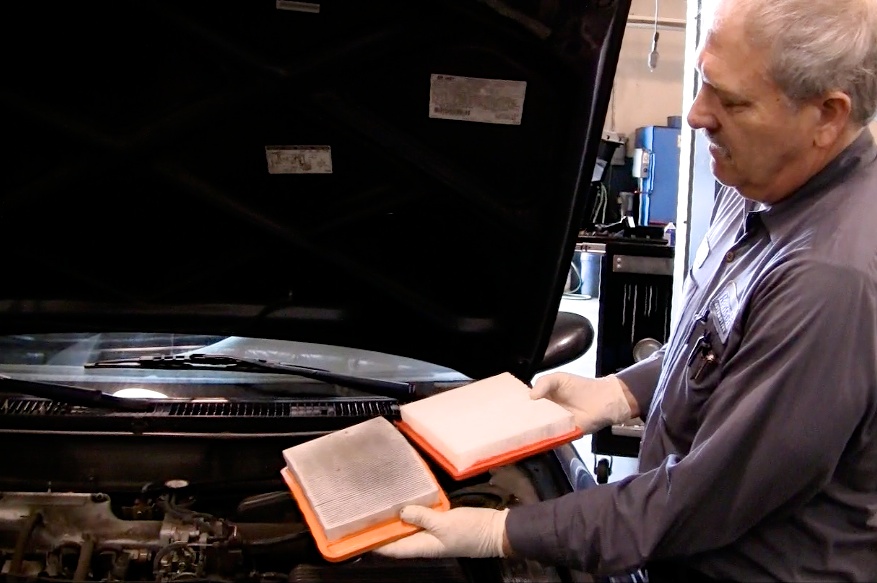
Dirty air filters can make the difference between passing and failing a smog check. Photo: Renson Automotive, Inc. ©2018
California takes air quality seriously, which is why all vehicles in the state (even hybrids) are required to pass regular smog tests. California’s emissions standards are some of the strictest in the country, and about 10 percent of vehicles fail. If you’ve been driving your car for years, it can be a shock when your vehicle suddenly doesn’t pass its smog test. But don’t despair—this is an opportunity to improve your car and make sure it’s not contributing excessive pollution to the environment.
What Does a Smog Check Look For?
As a combustion engine consumes gasoline or diesel fuel, it releases chemical compounds through the tailpipe, specifically hydrocarbons, carbon monoxide, nitrogen oxides, carbon dioxide and oxygen. While car engines have improved over the years at reducing the amount of harmful emissions, a certain amount will still be present. During the smog check, your car’s On-Board Diagnostics (OBD) system will indicate any problems to the technician. Older vehicles are evaluated via an emissions tester placed in the tailpipe. The test takes 20 to 30 minutes to perform.
Why Do Cars Fail Smog Tests?
If your car fails its smog test, you are required to do the necessary repairs before you can renew your state auto registration or sell your vehicle. Because there are many elements to the engine that make up the emissions system, there are numerous possible causes. Some repairs are easy fixes, while others point to more serious engine trouble. Here’s a partial list of possible causes:
Dirty air filter: If you haven’t replaced your car’s air filter in a while, it could be the cause of your smog test failure. Thankfully, it’s also an easy fix.
Leaking gas cap: Another easy fix, a gas tank cap that’s cracked, worn or improperly sealing could lead to an increase of emissions.
Defective ignition system: This is usually caused by old or defective spark plugs or wires. When a vehicle’s ignition system operates inefficiently, it releases more hydrocarbons.
Evaporative emission control system (EVAP): This system prevents your car from releasing vapors from raw gasoline into the atmosphere. Further testing can determine if the problem lies in the vacuum hoses, vents, purge valves or elsewhere.
Catalytic converter malfunction: The catalytic converter’s job is to turn the hydrocarbons, carbon monoxide and nitrogen oxide released by the engine into carbon dioxide and water. Any problem with this component could lead to smog test failure. Because catalytic converters are made with expensive materials, repairs are often costly.
Next Steps
If your car fails its smog check, a test-only center will give you a report that lists the possible reasons. A test-and-repair location can also provide service to prepare your car for a retest. Don’t delay repairs—you won’t receive your car’s registration stickers from the DMV until the vehicle clears a smog test.
Individuals facing financial duress can apply for a waiver if their cars fail the smog inspection. California’s Bureau of Automotive Repair provides assistance for qualifying individuals unable to pay for necessary repairs.
Tips for Passing Your Next Smog Check
The best way to ensure your car passes its next smog test is to perform regular maintenance. Consistently changing the oil, air filter, spark plugs and other parts that wear down will help your car’s engine operate efficiently for longer. If you’re concerned that your car isn’t running at its best, you can improve its chances of passing an upcoming smog test with these strategies:
Get a tune-up (but not right before the smog check). A tune-up is a great way to find and address any problems that could lead to a smog test failure. However, your car’s battery is disconnected during a tune-up, which resets its computer (and the emissions monitoring system). After you’ve driven about 100 miles, your car’s monitoring systems should be functioning normally.
Do some highway driving. Your car’s catalytic converter only operates when the car is running at higher speeds. Doing this will help burn off any oil and gas residues in your engine that accumulated while your car idled in traffic.
Try a fuel additive. There are many different kinds of fuel additives, including ones that are designed to reduce emissions. These formulas will flush out carbon deposits and allow gasoline and air to move as intended through the engine.
Get a pre-inspection check. Many auto repair and smog check stations will offer pre-inspection services, enabling drivers to fix problems before the test. If it has been about two years since your last smog check and you’re concerned about your vehicle’s ability to pass, a pre-inspection is a wise precaution.
Find a Diamond Certified smog check or auto repair shop in your area.
